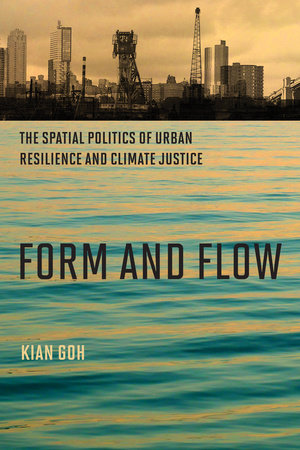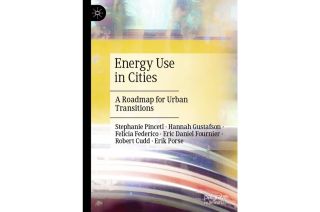
www.buildingsandcities.org/insights/reviews/form-and-flow.html
Form and Flow: The Spatial Politics of Urban Resilience and Climate Justice
By Kian Goh. MIT Press, 2021, ISBN: 9780262367066
Linda Westman applauds this book which eloquently explores the intricacy of how plans to protect cities against the impacts of climate change are devised, by whom, and with what socio-spatial consequences. The book is worth reading for its ability to hold on to hope and its search for emancipatory action despite all odds.

At its heart, the project consists of selecting a group of people to formulate and direct strategic plans… We shall call them the Wallfacers because that ancient Eastern name for meditators mirrors the unique characteristics of their work… the thoughts and behaviors these Wallfacers present to the outside world will be entirely false, a carefully crafted mélange of disguise, misdirection, and deception… a huge, bewildering maze of illusions is erected to make the enemy lose its judgment. (Liu, 2015, p. 100)
How do civilizations respond to profound existential threats? Science fiction author Liu Cixin has provided compelling insights by portraying the exceptionally contrived political manoeuvres devised by the UN system to defend the Earth against an extraterrestrial threat. Ultimately, the grand scheme is coopted and converted into new forms of unanticipated danger. In Form and Flow, Kian Goh brings us on a journey that likewise explores how political leaders and activists design plans to protect human settlements against the hazards of climate change. As in Liu's imaginary universe, Goh illustrates how grandiose plans can go wrong in unintended ways, but also how new politics emerge from efforts to resist such structured interventions.
Form and Flow interrogates how plans to protect cities against the impacts of climate change are devised, by whom, and with what socio-spatial consequences. The central question organizing the book is how 'contesting visions of urban futures [are] produced and how do they attain power'? The question is brought to life through engagement with climate politics in New York, Jakarta, and Rotterdam - three cities revealed through the analysis to be interlinked discursively and materially.
Goh adopts three methodological approaches to explore (and reimagine) urban resilience in the three urban areas. First, she examines the dynamic interaction between top-down urban climate plans and local mobilization that emerges as a form of contestation of those agendas. Second, she traces the complex interconnections of urban climate adaptation policy that have formed between cities, across time and space. Finally, she engages with design as an explicitly political and justice-oriented approach to urban climate action. Through all three angles, the analysis maps how diverging future visions produce imprints on the urban fabric alongside highly uneven effects on people's lives.
Form and Flow advances conceptual debates on urban resilience and justice in at least two ways. First, the book is situated in the expanding scholarship that explores how climate change interacts with colonialism. Previous work has explained how climate change was fundamentally constituted through the establishment of an imperial world order and global capitalism (Ghosh, 2018), as well as how climate impacts contribute to the everyday reproduction of coloniality (Sultana, 2022). Goh advances this conversation by carefully tracing the matrices of global knowledge that shape urban climate interventions.
In doing so, she provides an unusually concrete illustration of how post-colonial power operates in practice. In Chapter 3, 'Nature of Flows', Goh maps the production of expertise on the management of flooding in the Netherlands and its conversion into an international knowledge machine. She conveys how this knowledge is transmitted around the world through global consultancies, transnational networks, and international partnerships. In Indonesia, the reader witnesses the impact of Dutch expertise on climate adaptation policy. Goh demonstrates its central position in environmental planning in Jakarta, including through flood hazard mapping and design of the Jakarta Giant Sea Wall. This input is rationalised on the basis of the unrivalled knowledge of Dutch planners in flood management ('Planning for water is a key export in which the Dutch hold undeniable pedigree' (p.107)); however, the Dutch presence is also legitimized through 'enduring postcolonial ties' (p.108). Here, colonial legacies manifest not as intangible ghosts from the past, but as webs of knowledge, economic dependencies, institutions, and interpersonal relations that saturate contemporary urban planning.
Second, Form and Flow presents the ambitious aim of combining scholarship on urban environmental planning with ideas and methods in design. Goh argues that design has been seriously downplayed in research on urban resilience and advocates its insertion into this field of work, especially through engagement that is locally grounded and reflexive. Chapter 4, 'Plans and Counterplans' offers a wealth of empirical material that demonstrates the promise of such an approach. In Jakarta, the book first outlines the extravagant design of the Great Garuda, a seawall constructed in the fashion of a nationalist symbol that epitomizes utopian, development visions. In contrast, Goh offers an insight into 'Kampung design activism', which represents the participatory reimagining and up-grading of informal settlements by citizens themselves. Alternative principles of managing risk come into view, but, more than this, Goh shows how design 'becomes part of a platform for organizing' (p.129). The analysis shows how engagement with the material environment and collective strategies for its reimagination produces pathways for often-marginalized citizens to gain agency. Similarly, an exposé of two very different interventions in New York (the Rebuild by Design program funded by the Rockefeller Foundation and the community based Red Hood Initiative) showcases the highly political and potentially empowering character of design. Goh's argument for developing a political ecology of design is compelling.
Still, the reader may ask whether design-based approaches to urban resilience truly are understudied? Alternatively, this gap may manifest in relation to the relative popularity and influence of certain branches of social science research on urban climate policy (e.g. economics, urban planning, management) in comparison with others (e.g. design, but also history, critical geography, communication studies, etc.). If the problem is one of visibility rather than academic neglect, we face a challenge that relates less to the pursuit of additional research and more to providing space for underrepresented disciplines in key policy conversations.
Another achievement of this publications is Goh's navigation of a highly intricate scholarship through accessible language. The opening chapter maps out the state of the art in the field of urban resilience research, including succinct summaries of why cities have come to be framed as sites of vulnerability, current debates on the concept of resilience, an outline of research and activism associated with climate justice, theories on urbanization, and approaches to design. These overviews are likely be useful for activists and practitioners in need of a solid overview of academic conversations on urban resilience and justice.
In addition, the material on community mobilization may serve as evidence of the importance and effectiveness of grassroots movements working for urban resilience (broadly understood). In particular, Chapter 2, 'Nature of Contestation', contains rich case study material on community action in New York and Jakarta, which makes a strong case for the importance of local knowledge and coalition bundling - both essential for resilience efforts to be of any relevance to people's lives. This argument resonates especially at a time when we may face questions on how to maintain the excitement around climate activism that followed the global spread of #FFF (Fridays For the Future) and the climate youth movements.
At completing this book, I find myself surprised not to be dragged down into the usual despair experienced at the documentation of climate change as a societal threat with extremely uneven impacts (although this point is clearly illustrated). Instead, I feel buoyed by Goh's commitment to local mobilization as a source of change. Goh is unflinching in her engagement with the marginalization and deprivation produced through business-as-usual climate plans. But she is also frank about the possibilities being generated in the now by communities working hard to improve their day-to-day existence. Form and Flow is worth reading for its ability to hold on hope, for its search for emancipatory action despite all odds.
References
Ghosh, A. (2018). The great derangement: Climate change and the unthinkable. Chicago and London: The University of Chicago Press.
Liu, C. (2015). The Dark Forest (J. Martinsen, Trans.). New York: Macmillan.
Sultana, F. (2022). The unbearable heaviness of climate coloniality. Political Geography, 99, 102638.
Latest Peer-Reviewed Journal Content
Acceptability of sufficiency consumption policies by Finnish households
E Nuorivaara & S Ahvenharju
Key factors for revitalising heritage buildings through adaptive reuse
É Savoie, J P Sapinski & A-M Laroche
Cooler streets for a cycleable city: assessing policy alignment
C Tang & J Bush
Understanding the embodied carbon credentials of modern methods of construction
R O'Hegarty, A McCarthy, J O'Hagan, T Thanapornpakornsin, S Raffoul & O Kinnane
The changing typology of urban apartment buildings in Aurinkolahti
S Meriläinen & A Tervo
Embodied climate impacts in urban development: a neighbourhood case study
S Sjökvist, N Francart, M Balouktsi & H Birgisdottir
Environmental effects of urban wind energy harvesting: a review
I Tsionas, M laguno-Munitxa & A Stephan
Office environment and employee differences by company health management certification
S Arata, M Sugiuchi, T Ikaga, Y Shiraishi, T Hayashi, S Ando & S Kawakubo
Spatiotemporal evaluation of embodied carbon in urban residential development
I Talvitie, A Amiri & S Junnila
Energy sufficiency in buildings and cities: current research, future directions [editorial]
M Sahakian, T Fawcett & S Darby
Sufficiency, consumption patterns and limits: a survey of French households
J Bouillet & C Grandclément
Health inequalities and indoor environments: research challenges and priorities [editorial]
M Ucci & A Mavrogianni
Operationalising energy sufficiency for low-carbon built environments in urbanising India
A B Lall & G Sethi
Promoting practices of sufficiency: reprogramming resource-intensive material arrangements
T H Christensen, L K Aagaard, A K Juvik, C Samson & K Gram-Hanssen
Culture change in the UK construction industry: an anthropological perspective
I Tellam
Are people willing to share living space? Household preferences in Finland
E Ruokamo, E Kylkilahti, M Lettenmeier & A Toppinen
Towards urban LCA: examining densification alternatives for a residential neighbourhood
M Moisio, E Salmio, T Kaasalainen, S Huuhka, A Räsänen, J Lahdensivu, M Leppänen & P Kuula
A population-level framework to estimate unequal exposure to indoor heat and air pollution
R Cole, C H Simpson, L Ferguson, P Symonds, J Taylor, C Heaviside, P Murage, H L Macintyre, S Hajat, A Mavrogianni & M Davies
Finnish glazed balconies: residents' experience, wellbeing and use
L Jegard, R Castaño-Rosa, S Kilpeläinen & S Pelsmakers
Modelling Nigerian residential dwellings: bottom-up approach and scenario analysis
C C Nwagwu, S Akin & E G Hertwich
Mapping municipal land policies: applications of flexible zoning for densification
V Götze, J-D Gerber & M Jehling
Energy sufficiency and recognition justice: a study of household consumption
A Guilbert
Linking housing, socio-demographic, environmental and mental health data at scale
P Symonds, C H Simpson, G Petrou, L Ferguson, A Mavrogianni & M Davies
Measuring health inequities due to housing characteristics
K Govertsen & M Kane
Provide or prevent? Exploring sufficiency imaginaries within Danish systems of provision
L K Aagaard & T H Christensen
Imagining sufficiency through collective changes as satisfiers
O Moynat & M Sahakian
US urban land-use reform: a strategy for energy sufficiency
Z M Subin, J Lombardi, R Muralidharan, J Korn, J Malik, T Pullen, M Wei & T Hong
Mapping supply chains for energy retrofit
F Wade & Y Han
Operationalising building-related energy sufficiency measures in SMEs
I Fouiteh, J D Cabrera Santelices, A Susini & M K Patel
Promoting neighbourhood sharing: infrastructures of convenience and community
A Huber, H Heinrichs & M Jaeger-Erben
New insights into thermal comfort sufficiency in dwellings
G van Moeseke, D de Grave, A Anciaux, J Sobczak & G Wallenborn
'Rightsize': a housing design game for spatial and energy sufficiency
P Graham, P Nourian, E Warwick & M Gath-Morad
Implementing housing policies for a sufficient lifestyle
M Bagheri, L Roth, L Siebke, C Rohde & H-J Linke
The jobs of climate adaptation
T Denham, L Rickards & O Ajulo
Structural barriers to sufficiency: the contribution of research on elites
M Koch, K Emilsson, J Lee & H Johansson
Disrupting the imaginaries of urban action to deliver just adaptation [editorial]
V Castán-Broto, M Olazabal & G Ziervogel
Nature for resilience reconfigured: global- to-local translation of frames in Africa
K Rochell, H Bulkeley & H Runhaar
How hegemonic discourses of sustainability influence urban climate action
V Castán Broto, L Westman & P Huang
Fabric first: is it still the right approach?
N Eyre, T Fawcett, M Topouzi, G Killip, T Oreszczyn, K Jenkinson & J Rosenow
Social value of the built environment [editorial]
F Samuel & K Watson
Understanding demolition [editorial]
S Huuhka
Data politics in the built environment [editorial]
A Karvonen & T Hargreaves



Latest Commentaries
Decolonising Cities: The Role of Street Naming
During colonialisation, street names were drawn from historical and societal contexts of the colonisers. Street nomenclature deployed by colonial administrators has a role in legitimising historical narratives and decentring local languages, cultures and heritage. Buyana Kareem examines street renaming as an important element of decolonisation.
Integrating Nature into Cities
Increasing vegetation and green and blue spaces in cities can support both climate change mitigation and adaptation goals, while also enhancing biodiversity and ecological health. Maibritt Pedersen Zari (Auckland University of Technology) explains why nature-based solutions (NbS) must be a vital part of urban planning and design.